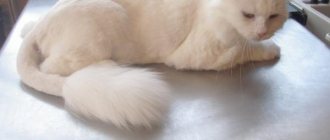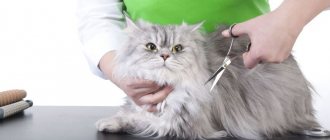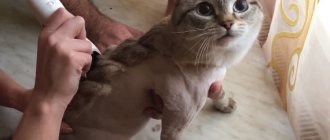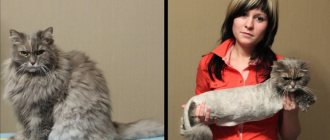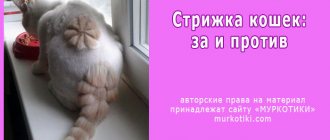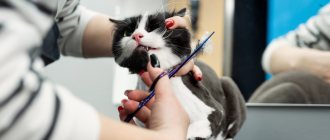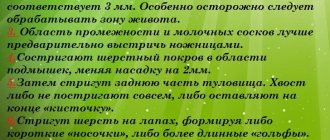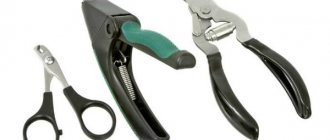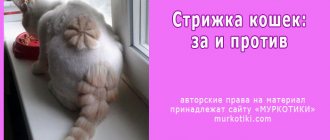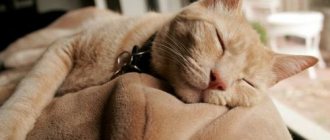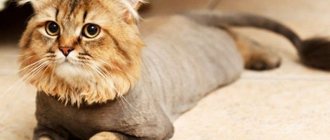If you decide to take an animal into your home, you will have to take care of it, keep it clean, and feed it nutritious food. Most often, cats appear in families, which themselves are gentle and affectionate animals, and it is a pleasure to play with them. If the owners are new, they have many questions about caring for their pet, for example, the rather pressing topic of keeping the fur clean and which cat breeds need to be trimmed. And immediately concern arises regarding the question of how to cut a cat’s hair at home.
After reading this article, you can make sure that the procedure does not present any difficulties.
Ridding an animal of excess hair is the key to the pet's health. Cats with long, fluffy hair most often need a haircut, because these animals shed much more than short-haired cats, and hairballs also constantly roll up, causing a lot of inconvenience. And in this case, the decision to trim the cat is a necessity; you just need to understand how to carry out this procedure yourself at home.
I would like to note that getting rid of excess hair from an animal is not only a guarantee of cleanliness and the absence of hairs throughout the house, but also a guarantee of a healthy pet. Cats constantly lick their fur, so the hairs penetrate into the stomach, and if this happens constantly, whole balls of hair begin to collect. In general, cats are able to regurgitate the collected fur, but this is not always possible, and as a result, obstruction of the gastrointestinal tract occurs. Therefore, a haircut is a necessary event.
Veterinary clinics provide animal grooming services. To trim a cat, you need to prepare yourself and prepare the animal. There are specialized veterinary clinics that provide hairdressing services for animals, and if it becomes a problem for you to do the haircut yourself, you can always turn to specialists, but the procedure will cost money.
What is used to groom cats?
Attention! At home, medium-sized scissors are used, but the most convenient option is a clipper.
A clipper is the most convenient for carrying out the procedure. This device, unlike scissors, is easy to use and cannot cause injury to your pet if used correctly. The only drawback is the sound of the machine running, which can greatly frighten the cat, and this will create certain problems during the grooming process (the animal begins to struggle and scratch).
If you are even afraid to imagine how to trim a cat at home, then you better turn to a professional. Some veterinary clinics use anesthesia for overly exuberant cats, but this is very dangerous for older cats.
At home, it is difficult to trim a cat for participation in exhibitions, but it is absolutely possible to do this for hygienic purposes.
It is advisable that the hair clipper operate quietly. For convenience and ease of cutting, the first step is to choose a high-quality model of the device, preferably not too loud and, of course, not the cheapest. The stores offer mechanical (manual) and electric machines. After studying all the pros and cons that the sales consultant can tell you about, you will be able to choose the most convenient option.
[custom_ads_shortcode1]
Instrument care
Thanks to the use of high-quality materials, professional line scissors do not require special care.
However, general rules for maintaining metal tools should be followed.
- Scissors should be stored horizontally. The ideal place for storage would be a special case, lined inside with suede or soft fabric.
- Before starting work, you need to check the tension of the sheath if the screw is adjustable.
- After use, scissors (but not cutting blades) should be wiped with a piece of soft cloth using a small amount of oil (special).
- Shearing scissors should only be used for cutting wool, and not for cutting flowers, paper or other materials.
Silent Scaredy Cut scissors do not require special care. They were originally designed for home use, so maintenance is kept to a minimum. Stuck hairs can be brushed off with a brush or rinsed under running water, then wipe the instrument dry.
Some manufacturing companies stipulate that the blades of their products do not become dull for a long time. But if the question of sharpening still arises, you need to contact a specialist. You should not try to sharpen the tool with improvised means, as this may render the scissors unusable.
How many times a year should a cat be groomed?
On average, depending on the breed and age, a cat's fur grows back to its previous size 3-6 months after shearing.
Attention! Experienced veterinarians recommend trimming your cat several times a year, and if tangled hairballs appear, cut them out with scissors.
It is recommended to trim the cat several times a year. It is advisable to trim the cat before the summer season, because animals, especially shaggy ones, endure the hot season too difficult, therefore, by learning how to carry out the procedure at home, you will help the cat cope not only with intestinal disease, but also make her feel better when the air temperature is too high.
[custom_ads_shortcode2]
Manufacturers
The range of tools for grooming cats is quite extensive. The cost varies depending on the brand, purpose of the tool, and material.
Scissors should be easy to use and maintain.
Scissors from the brands Zolux (France), Ferplast (Italy), Trixie (Germany), Witte Rose Line (Germany), Geib Buttercut (USA) have proven themselves well in the household and professional spheres.
The tools from these brands are easy to use and suitable for home care.
Professional scissors are made of durable materials - stainless steel, with an additional titanium coating and therefore will last a long time without losing their qualities.
How does haircut affect animals?
Is it possible to cut a cat's hair without causing any changes, and how will cutting it at home affect the pet's behavior?
Haircut significantly affects hair growth. In almost all long-haired breeds, the color of the coat changes, acquiring a darker or lighter shade. It happens that haircut significantly affects the growth of fur, sometimes this process accelerates, and in some cases, on the contrary, it becomes slower, and in rare cases it stops growth completely.
[custom_ads_shortcode3]
Main nuances
Cat owners should be aware that not all animals can have their fur trimmed. The restrictions may be influenced by the following factors:
- Color-point or typing type of color. In this case, the regrown hair on the belly and back will be darker in color than before the haircut.
- Unbearable character and increased activity, when the pet cannot be brought into a calm state. In such a situation, you can use anesthesia, but first you need to take into account all the possible risks. Narcotic drugs can cause cardiac arrest, put you into a coma, and contribute to the failure of the kidneys and liver. If there is no other solution, anesthesia can be replaced with sedatives or muscle relaxants. But such an idea must be approved by a veterinarian, and drugs must be administered strictly under his guidance.
- It is not recommended to cut short-haired cats unless absolutely necessary, since in the heat their vital functions are not disrupted and tangles never form. Grooming of such breeds is only relevant in extreme situations, for example, if the animal is soiled with oil paint.
When planning to cut your cat's hair, you should be aware that the structure of its fur, length and color may change, and the regrowth process usually takes several months. It is forbidden to cut the hair on the animal's head, on the pads of the paws and in the inside of the ears.
How to properly trim your pet's hair yourself?
To understand how to properly trim a cat at home, you need to prepare:
- a convenient place, it can be a table or an ironing board;
- a comfortable comb;
- small scissors;
- a special hair clipper;
- hydrogen peroxide and iodine (for treating wounds, if any appear).
[custom_ads_shortcode1]
Sequencing:
- Initially, you should shorten your cat's claws. For this, manicure scissors are usually used: firstly, this tool can be found in every home, and secondly, high-quality scissors will help you deal with claws without unnecessary problems; If you wish, you can purchase a special device at a pet store - a nail clipper, which is easy to use, and its cost is quite affordable.
- Before you start trimming the nails, you need to disinfect the tool, usually using alcohol. Next, you need to take your pet’s paw in your hand and lightly press on the pad, after which the cat will release its claws, at this moment, without removing your fingers from the pad, begin the procedure of cutting the claws; To complete the procedure, it is recommended to use a nail file to file off the sharp ends.
- For the first time, it is better to trim a cat at home, with the help of a person who will help you hold the animal correctly, and, as a rule, it is much easier to cope with the procedure together. So, the partner, having laid the cat on its side, must hold its limbs.
- If the animal begins to behave quite aggressively, it is better to use a plastic collar.
- Next, they trim the cat with a clipper, starting from the sides, the main thing is not to worry and try not to shake your hands, because an animal that behaved calmly, sensing the owner’s excitement, can show both anxiety and aggressiveness, and then you will no longer be able to do the procedure at home.
- After the sides, the back and belly are trimmed; Particular attention is paid to the abdominal area where the nipples are located.
- It is possible to cut the hair both in the direction of hair growth and against it.
- If the haircut is carried out with an electric clipper, you need to remember that the nozzle must be at least 3 mm.
- In order for everything to go without injury to the animal, you should trim the resulting lumps on the cat with scissors during the procedure, since using a clipper at home this will be impossible and quite unpleasant for the pet itself.
- During grooming, the animal's skin must be stretched to avoid cuts.
- When cutting hair at home, the head, paws at the ends and tail are usually left untouched; this haircut will look like a lion's.
- If necessary, you can use thinning scissors to go through the untrimmed wool.
- When the whole procedure has come to an end, the cat is washed with clean water, or bathed with shampoo and dried with a hairdryer.
It is possible to cut the hair both in the direction of hair growth and against it.
[custom_ads_shortcode2]
Grooming with the help of a veterinarian
At home, cats often become, if not masters, then full members of the family. They perceive attempts to give medicine, trim claws or examine teeth negatively, running away, dodging or attacking the person. Similar behavior is observed when cutting hair. The animal hides in inaccessible places and attacks scissors or a machine.
In the veterinarian's office, your pet's behavior changes. Some are violent, but many resort to verbal resistance. That is, by continuing to howl and growl, the cat allows manipulations, such as injections and haircuts.
Hair styling is one of the services offered by animal clinics. It is quite expensive (comparable to minor, non-cavity surgery) and may involve anesthesia. The latter poses a risk to the life and health of the pet. On the Internet you can find reports of cats put into hibernation while their fur was being groomed, but which never woke up.
A professional machine, available in most offices, will quickly remove excess hair. In this case, the owner can use the tool himself while the veterinarian holds the cat - specialists are better at this task.
Distract or tire your pet
Do you want to know how to calm a cat down for a haircut? His favorite toys can help with this. Animals of both sexes may be attracted to pillows, soft toys, large spools of thread, and other objects. During the grooming process, these objects serve as “passive” entertainment - the pet does not chase them around the house, but clasps them with all its paws, simulating a fight.
The animal fixes the object it likes, paying little attention to the environment and the manipulations that are performed with it. The choice is yours to decide how to calm your cat before grooming.
In this state, the animal will allow you to trim not only its fur, but also its claws. The main thing is to monitor changes in your pet’s behavior. Eventually he may get tired of it and begin to show aggression towards the hairdresser.
Not wanting to affect the psyche, the owner can try to exhaust the pet in order to reduce the negative reaction to the haircut. For example, feed generously or have an active play session lasting at least 30 minutes.
After waiting 15-20 minutes after the cat lies down to rest, you can approach with scissors or a clipper. A tired animal may be more loyal to the procedure for some time. But this approach to cutting will require several stages - even with a clipper it will be difficult to cut off all the wool at once. During this time, the pet can also get used to the tool and begin to react less to it.
Immobilize or sedate
It is not recommended to use anesthesia and sleeping pills to create a hairstyle, but you can use more gentle drugs. Herbal-based products, like Kota Bayun, are suitable. But you need to start giving them at least a week before the procedure - the drug must accumulate in the body.
When choosing how to calm your cat before grooming at home, it will be more effective to use physical remedies instead of over-the-counter medications. By holding a cat by force, you suppress his will, thereby risking causing him depression or a nervous breakdown. Although such actions can radically stop aggression.
For cutting, it is recommended to hold the cat by the scruff of the neck. According to one version, the animal calms down, remembering how his mother endured him like this in childhood. The restrained pet is laid on its side and the hair is cut off - a job that, according to the Internet, can be done by one person. In reality, stupor when the scruff of the neck is grabbed does not always occur - the animal may continue to struggle.
A greater likelihood of success will be ensured by working in pairs: one person immobilizes the pet’s paws, lying on its side, the second person cuts the hair, additionally holding the body. But in this case, the cat often shows more aggression, offended by the “group attack.”
A compromise option is to cut your hair yourself using a bell collar. Plastic will prevent your pet from biting, and the absence of extra hands will make you less nervous. If the animal struggles too actively, you should stop working so as not to injure it with the cutting tool or damage the limbs.
It is better to ask a specialist for help or postpone the haircut to a time when the pet is calmer. Cats rarely agree to voluntarily give up their fur, even if it would benefit them.
You can try to calm the animal by moving it to a stressful hospital environment or by redirecting its attention to a toy.
In any case, it is better not to manipulate scissors and the machine alone. Since there is a chance that you will not hold the cat and it will get hurt trying to free itself from you and run away.
Do you know how to properly trim a cat's claws?
Separately about the British cat
The British breed is a short-haired breed, so it is customary to care for the animal’s fur without cutting it. Short hair does not mat in clumps, so there is nothing to cut. To keep your cat looking neat and well-groomed, use soft brushes to comb its fur.
Usually these are rubber or bristly brushes that are not capable of damaging the integrity of the animal’s skin. And, of course, the British are periodically bathed with a special shampoo, because cleanliness for cats is a guarantee of good health.
Cats of this breed are quite impressionable, so before starting the procedure, it is better to first find a video on the Internet on how to trim a Persian cat at home.
For Persian cats, a haircut similar to that of a lion is used. To groom cats of this breed, it is better to involve assistants who will help calm the animal. For Persian cats, they use a haircut similar to that of a lion - the head, tail and paws are left unchanged, this is a classic hairstyle for representatives of this breed.
[custom_ads_shortcode3]
Grooming and its types
The goals of grooming vary. Some owners prepare their dogs for an exhibition, others want their dog to be known as a “neat guy,” and still others want a creative and extraordinary appearance for their pet. Depending on the intent of the cosmetic procedures, there are several types of grooming:
- Hygienic.
- Home.
- Exhibition.
- Creative.
Hygienic. Includes a hygienic haircut (cutting hair in the groin and under the tail) once every 2 weeks - 1 month. It is advisable to do it before swimming. After trimming, it will be easier for the owner to care for the animal. In this case, a haircut along the body is not expected. This method of cutting hair is suitable for dogs in several situations:
- If the dogs belong to breeds that do not need a full haircut. These include both fluffy varieties: huskies, huskies, shepherds, and smooth-haired animals: Dobermans, Dalmatians, bull terriers.
- If the dog is not yet fully grown after the haircut, but needs light hygienic care. Some breeds undergo this procedure between haircuts to always remain well-groomed and look great. Such “dandies” include: poodles, Scotch terriers, Spitz, Pekingese.
- If the animal constantly participates in exhibitions. Accordingly, it requires regular hygienic care between haircuts. Most often this applies to breeds with full-length hair - Maltese, Shihtzu, Yorkie.
In addition to the “sanitary” haircut, hygienic grooming includes a set of standard procedures: cleaning the ears and removing excess hair from them, cleansing the eyes, teeth, trimming the nails. Much attention is paid to the paws. Excess hair is trimmed between the toes and pads, and the hair on the limbs is shortened in a circular manner.
Grooming and its types
Home grooming has one important feature. Its main goal is to give the dog a neat appearance, make it visually attractive and clean. In this case, it is not necessary to adhere to the breed’s conformation standards. A haircut is done more for the sake of hygiene and convenience, rather than for exhibition “beauty”.
Exhibition. But for this type of grooming, the entire procedure is performed strictly according to established rules. Moreover, when making an exhibition version, the master strives to maximally emphasize the advantages of the exterior, and, of course, tries to make the disadvantages of the four-legged appearance invisible. But all these manipulations are carried out in accordance with the requirements of the breed.
Creative. There are not and cannot be any rules, norms or restrictions. After all, when ordering such a service, the owner wants to give his dog’s exterior the most extravagant look. This is done mainly through original curly haircuts, when intricate patterns are cut on the animal’s fur.
There are other techniques through which groomers manage to turn even an ordinary dog into a work of art: dyeing the fur, adding decorative elements - rhinestones, feathers. Some experts are so keen on the creative option that they create dogs that look like pandas, dragons, dinosaurs and cartoon characters.
What time of year do cats get their hair cut?
Attention! Pets that do not go outside can be groomed, regardless of the time of year. Animals that constantly run outdoors are usually trimmed before the onset of the summer heat.
None
Grooming of their pets has recently become popular among cat owners.
And since this service from professional “cat hairdressers” is not cheap, many owners are not averse to learning how to cut their cat’s hair themselves.
[custom_ads_shortcode1]
Why cut your hair and how often?
There are several reasons for getting a haircut. They can be divided into two main groups: health (pet and owner) and beauty. As for health, the motives are as follows:
- Your cat has started to develop multiple mats.
- Problems with the gastrointestinal tract have appeared (vomiting or constipation due to ingestion of fur).
- There were problems with molting (the process took too long). Although they can simply be resolved with patient daily combing. But cutting is a necessary measure when the cat reacts aggressively to any grooming.
- The owner is allergic to cat hair. A trimmed cat will indeed have less fluff, but trimming it will not completely solve the allergy problem.
- It is easier to remove burrs, ticks and fleas from a trimmed pet (if the cat is walking outside).
None Another type of motivation for cutting hair is fashion. As a rule, Himalayans and Persians are cut. But owners of any breed of long-haired cat can give their pet a stylish haircut. In this case, grooming is done no more than once every four months.
Important! The opinion that a trimmed cat can withstand the heat easier is nothing more than a myth, since it is a well-groomed coat that allows the animal to maintain thermal balance and avoid overheating.
[custom_ads_shortcode2]
In the salon or at home?
Do you want to cut your cat's hair at home in Moscow? Don’t know where to get a cat’s haircut and how much it costs? Our cat hair salon will give your cat a cheap haircut at home with a free technician visiting Moscow with service like in a salon.
Cat grooming at home is performed by experienced professionals with at least 3 years of continuous work experience. With us you can cut your cat’s hair inexpensively and efficiently in a short time and at a low price of 1090 rubles .
Cat groomers come with their own sterile tools and cosmetics by appointment. All you need is a table and a power outlet. Cat grooming can be done either with a machine or with scissors, at your discretion. Prices for cat grooming and additional services are listed on our website.
Now you know where to get a cat’s haircut at home in Moscow inexpensively and with high quality, without overpaying for a cat’s haircut in a salon and, at the same time, saving a lot of time.
Why do you need to groom your pets?
Cat owners provide their furry friend with balanced nutrition, care and care. To ensure that your purr is always beautiful and healthy, it is important to properly care for his coat. The cat should have clean, healthy fur. But the home beauty cannot always cope with this.
This is especially true for long-haired cats. In addition to other types of hair care, it needs to be cut. And the hair needs to be trimmed not because it grows like a human’s – in length. There are other reasons:
- Long hair gets matted into pellets and tangles. Bacteria, fungi and often infectious ones settle in them, which often cause diseases in animals and humans.
- Wool makes it difficult for the skin to breathe, causing the animal to overheat. This provokes skin diseases and can worsen the general condition.
- A haircut is necessary if there is increased secretion of the glands, including the anal glands.
- When a cat licks itself, it swallows fibers that form balls in the stomach. The animal does not always cough up these balls. Often the gastrointestinal tract becomes so blocked that only a veterinarian can help. One of the common reasons for haircuts is shedding.
- It is difficult for older animals to care for their fur on their own. A haircut will prevent such troubles and protect the cat’s health.
Removing tangles
It is impossible to wash an animal in stubborn tangles or in solid felt. The wool fades, does not dry, and macerations form, causing inflammation of the skin. You cannot pull out tangles - you will cause pain to the animal.
Sometimes oils help to make combing easier and mat cutters (the mat is divided into parts and gradually dismantled). If these options do not help, only a haircut will save the sufferer. The mats are trimmed with a clipper.
Contact only specialists! If you are planning this procedure, do not feed your cat for 6 hours before grooming - in case of using sedatives. Be aware of your cat's temperament.
Experienced specialists, using special fixation and assistants, cut hair without using anesthesia - a haircut that takes 20-30 minutes is not worth it, take care of the health of your affectionate friend! Relief from tangles occurs already on the table during the grooming process, and many cats patiently endure this procedure and are grateful in their own way.
Required tools and accessories
The first haircut can take four hours. Over time, when you have experience, you can do it in an hour. To cut your cat's hair with a clipper you will need:
- a second person to hold your pet;
- trimmer with attachments;
- slicker;
- wide-toothed comb;
- nail clippers;
- several towels or a blanket;
- cat treat.
Nail clippersAttention! If your animal has dirty areas or mats on its body, you may also need some cornstarch and blunt-tipped scissors.
[custom_ads_shortcode3]
What is meant by grooming and why is it needed?
Grooming refers to a whole range of activities necessary to care for an animal:
- Nail trimming.
- Combing wool, untangling matted areas.
- Grooming of domestic cats, especially long-haired breeds.
- Ear cleaning.
- Eye care.
- Trimming the fur between the fingers.
- Removing tartar and generally caring for your pet’s entire oral cavity.
- In some cases, grooming includes cleaning the anal and other glands.
The word comes from the ancient designation “groom” - a person whose profession was caring for an animal, primarily a horse. Nowadays, the term has passed on to any “hairdresser” for animals, and the professional himself is more often called a “groomer.”
Model haircut "French Lion"
How to trim a cat's fur?
If you decide to groom and don’t know how to cut a cat’s hair at home, then this step-by-step instruction will help you. Step 1. Choose a place for cutting. It is better to cut the animal in a room where there are no carpets. Trying to remove large amounts of cat hair from your carpet with a regular vacuum cleaner can be a pain, not to mention the hairs will clog the dust collector.
Choose a wide window sill or table as your workplace. Step 2: Prepare the area Cover a windowsill or table with a couple of old towels or a blanket. This will add a little cushioning, which will make the grooming process more comfortable for the cat, and will protect the surface of the table/window sill from cat scratches.
Find the nearest outlet and plug in the trimmer. The distance should be sufficient to allow the device cord to sag and provide room for maneuver. Step 3.
Bring the cat to the prepared area Before you begin grooming, let the cat get comfortable in the place. Give him a treat and petting him for a few minutes will calm him down and allow you to spot tangles and dirty areas.
Step 4: Remove the claws To do this, hold the paw in one hand and gently press on the cat's finger to pull out the claw. Remove only the sharp tips, avoiding the epithelial tissue that protects the claw.
Clipped Siamese catImportant! A short-trimmed claw will cause pain in the cat, and damage to the epithelial tissue is traumatic. If you are unable to trim your nails yourself, contact a professional groomer or veterinarian.
Advice! Trim your nails a day or two before trimming. If you do everything at once, the cat will get nervous.
Step 5. Comb your pet Comb the scruff of the neck, back and belly with a slicker brush. You will probably need a helper to gently hold your cat while you brush the belly area. Brush the paws and tail with a wide-tooth comb.
The following steps should be taken if the animal has matted fur or mats:
- Remove tangles using a slicker brush. Hold the matted fur to avoid stretching the skin, which can be very painful for the cat. This will take a few minutes. If you can't comb the problem area of fur, use blunt-tipped scissors to cut it off.
Important! Make sure that when cutting the mat you do not catch the skin with scissors (in cats it is very thin and easily injured).
- Rub a small amount of cornstarch into the problem area and comb it out after a while. This will help dry out the dirt on the coat.
Step 6. Cut the cat's hair If you want the hairs to be a little longer, cut in the direction of growth of six. In short - against the grain. To create a lion haircut, start from the back and sides. Glide the trimmer in a straight line from the root of the tail to the head.
Attention! Trim carefully, without pinching the skin - this can injure the animal.
After each pass with the machine, remove any hair from the blades. Stop periodically to remove the trimmed fur from the cat. This will make it easier for you to see the missed areas. Keep your cat's skin taut all the time to avoid injury to the skin.
Mei Coon with Lion Cut Once you have trimmed the fur on the back and sides, lay the cat on his side and comb the fur on his belly. While your assistant holds the cat, carefully trim the fur around the nipples, genitals, and the rest of the tummy.
When cutting the tail, leave the fur on only the last quarter of the tail. However, not all cats like to trim this part of their body. Therefore, in order not to irritate the animal, do not cut the tail at all. The hair on the paws is usually not cut (or down to the knee/elbow joint).
Step 7. Form the mane Leave the withers, part of the back and belly uncut - this way you will form the mane “like a lion”. After grooming, wipe the area with a damp cloth to remove any cut fur.
Step 8. Grooming is complete, pet the cat and give him a treat.
[custom_ads_shortcode1]
Application
An aqueous solution of formaldehyde (methanediol) stabilized with methanol - formalin - causes denaturation of proteins, so it is used as a tanning agent in the tanning industry and tanning gelatin in the production of film. Due to its strong tanning effect, formaldehyde is also a strong antiseptic; this property of formaldehyde is used in medicine (Formidron, Formagel and similar preparations) and for the preservation of biological materials (the creation of anatomical and other preparations).
Formaldehyde is used as a fumigation agent, in particular during the storage and transportation of grain.
An aqueous solution of formaldehyde (methanediol) stabilized with urea - KFK - is one of the most important sources of formaldehyde and urea in the production of urea-formaldehyde, melamine-urea-formaldehyde resins and for the treatment of urea against caking; used in the woodworking and furniture industries for the production of plywood, chipboard, etc.
The main part of formaldehyde is used in the production of thermoset polymers (phenol-formaldehyde, urea-formaldehyde and melamine-formaldehyde resins); it is also widely used in industrial organic synthesis (pentaerythritol, trimethylolpropane, etc.).
During storage (at temperatures below 9 ° C), the formaldehyde solution becomes cloudy and a white precipitate (paraformaldehyde) precipitates.
Registered in the food industry under code E240.
After the haircut
If this was the first time for your cat, he will want to hide for a while. This is normal and after several groomings he will become more relaxed about the haircut.
In general, grooming is a stressful situation for an animal. A short-haired cat may not sit on its hind legs for some time (or sit down and immediately get up), be depressed, and hide. Changes in the structure of the coat are possible: new hairs may grow thinner and quickly roll into tangles. Some areas on the animal’s body may not develop hair at all because the skin has been exposed to hypothermia.
But there will definitely be changes in the structure of the skin: it will become less elastic, dry and lose its elasticity. But no additional skin treatment is required after cutting. You just need to surround your pet with care and love.
Trimmed Scottish catAttention! After a haircut, the skin will be more sensitive to any changes in the environment (drafts, direct sunlight, air conditioning, etc.).
[custom_ads_shortcode2]
Popular haircuts
There are two categories of haircuts: model and hygienic. Hygienic goals pursue the following goals:
- removing tangles;
- removal of parasites;
- straightening the coat after removing tangles.
Model ones are often made for exhibitions or simply as a tribute to fashion. The most popular model haircuts are:
- lion (fur is left on the head, withers, tip of the tail and the bottom of the paws);
- dragon (except for areas of fur on the head, withers, tip of the tail and the lower part of the paws, a strip is left on the spine, on which notches are made using filigree scissors);
- puma (the head, paws, tail and body remain intact, level with the front paws);
- puss in boots (like a lion haircut, only the hair on the paws is left at a higher level).
[custom_ads_shortcode3]
Cat Hairstyle Trends
There are many models of fashionable haircuts. Basically, the choice depends on the imagination of the groomer or owner, and the characteristics of the breed.
However, there are several main options for cats that have become classics (see photo):
- A lion. A common hairstyle for large breeds: Maine Coons, Norwegian Forest cats, Siberian cats. The fur on the body and legs is cut short (0.5 cm), remaining on the head, neck, chest, and tip of the tail. A lion haircut is considered both hygienic and fashionable. However, in the latter case it may not always turn out beautifully, especially if the hair tangles behind the ears.
- Puma. The hairstyle is similar to a lion, only the fur coat remains on the front part of the body and front legs. They also form socks on the hind legs, leaving a tail or its tip. The back of the body is trimmed with a machine. The hairstyle received another name - “sheepskin coat”.
- Puss in Boots. The hairstyle is similar to a lion, but there is no mane.
Lion and cougar are considered basic cat haircuts, but they have several options for tail and paw treatments:
- Christmas tree. The base of the tail is cut, then 2 more small sections at equal intervals. The result is 3 triangles.
- Squirrel. The tail remains fluffy and is shaped using thinning scissors. Only the base of the tail is trimmed.
- Brush. The size varies depending on the wishes of the owner. The shape of the tip does not change.
- Broom. The same as a brush, only the edge of the tip of the tail is cut straight.
- Knee socks - up to the middle of the paw are cut with a machine, the rest is formed with scissors.
- Socks are a shortened version of golf.
Additionally, it is possible to cut various patterns. For example, the Dragon or Dinosaur hairstyle in different versions is considered popular. The cat turns out to be completely shaved. Only the mohawk, stepped comb, stripes, and teeth are left on the back. The tail is either patterned or like a lion haircut.
Why and how often should you cut your cat's hair?
The most common reason why cats are cut is the owner's desire to give the animal an unusual look. Model pet haircut is one of the modern fashion trends. Cats are also given a haircut before participating in professional exhibitions. Some owners believe that cutting their furry pet's hair is necessary in order to relieve it of discomfort in hot weather.
However, shortening the fur due to heat is not practical for many felines. The coat of cats is a kind of regulator that helps with excess heat and cold. Persian cats are most often affected by hot weather. However, cats are cut for other reasons:
- Fur stains that cannot be removed by bathing. The pet can get dirty with machine oil, paint, and building materials. In some cases, the animal's fur needs to be shaved.
- Formation of tangles that cannot be combed out. Sometimes shedding occurs so intensely that the owner does not have time to remove the fallen fur. The tangles cause discomfort to the animal, and chafing and rashes can form underneath them. Pieces of fur can get into your pet's stomach when he tries to lick them, which will lead to the formation of hairballs in the stomach.
- The animal is not able to care for its fur. If the pet is weakened, long hair will contribute to overheating.
- Long intense molting. A haircut will make it easier for the owner to care for the pet. Often they resort to eliminating long hair when a baby appears in the house. Lost hairs can rise into the air and settle on children's objects.
- The need for medical procedures. When treating dermatitis, burns and other pathologies, it is sometimes necessary to apply ointments and creams. Long hair will prevent this. Also, after a haircut, it is easier to observe the results of therapy.
The frequency of haircuts depends on the reason for it. If the coat is shortened for decorative purposes, the procedure is carried out 2-3 times a year. To eliminate the risk of overheating, haircuts are done in the warm season.
If the animal is weakened, the procedure is carried out as the hair grows back. The rate of coat renewal depends on the breed of the cat. On average, the process takes 3–6 months.
[custom_ads_shortcode2]
Hygienic grooming
Hairdressing and hygiene procedures for animals are the most practical care option, which consists of general cleaning of the surface of the pet’s body, shortening claws, cleaning ears and teeth, combing and cutting off matted fur. Hygienic grooming is relevant for Siberian, Norwegian, Himalayan, Angora and Persian cats, and in addition for breeds such as Maine Coon, Burmilla, Laperm, Selkirk Rex, Munchkin, Highland Fold, Lowlander (British Longhair) and some other representatives of the cat family.
Reasons for the procedure
Hygienic grooming relieves long-haired cats from clogging their stomachs with lint during the molting period, and relieves owners from fluffy deposits on clothes and interior items. The growth and loss of fur in cats is a continuous process, but once or twice a year, when shedding begins, the fur falls out intensively. This is the only inconvenience associated with long-haired felines that hairdressing services can successfully solve.
The reasons for carrying out hygienic grooming in the salon or at home are the following reasons:
- Too voluminous and long hair in the summer or at high room temperatures contributes to overheating of the pet’s body.
- An aged animal cannot cope on its own with maintaining its coat in perfect condition.
- If there are pathologies of the gastrointestinal tract, then ingestion of a large number of hairs by a cat, especially during the molting period, can aggravate its health condition or negatively affect treatment.
- Increased secretion of substances of specific action (secrets) by the endocrine glands.
- Skin diseases, the treatment of which is hampered by long hair.
- Clumped and tangled pile, which is a symptom of various diseases.
- Mats and matted fur.
Pros of grooming:
- No wool deposits on upholstered furniture and clothing.
- It is easier to wash your pet and there is no need to dry it with a hairdryer.
- In summer, the cat does not languish from the heat.
The protests of cat owners who express a negative position regarding visiting pet hairdressing establishments are understandable. And they are based, first of all, on the fear of harming a defenseless creature. But you need to approach any event sensibly: if you eliminate all possible risks when carrying out grooming, then if the need arises, you can do a pet haircut.
Minuses:
- Stress for a pet that is unaccustomed to interference in its life from strangers.
- Possible abrasions on the cat’s body if hairdressing manipulations are performed by an unprofessional master.
- Undesirable consequences of using anesthesia in case of an allergic reaction.
Which cats are contraindicated for trimming?
Experts do not recommend cutting smooth-haired cats. Their fur does not form tangles, and its complete absence will increase the risk of injury to the skin. It is contraindicated to trim cats if:
- The color of the animal is color point or tipping. After regrowth, the coat may change, and the cat will lose its unique color.
- It is contraindicated for the animal to be nervous. Some cats have medical conditions that make stress life-threatening. Grooming is not a natural process for a pet, so in most cases it makes him worry.
- The previous procedure had a negative impact on the pet's health.
- The cat lives in an area with high solar activity and spends a lot of time outside. By trimming a pet, the owner deprives him of protection from the negative effects of ultraviolet radiation.
[custom_ads_shortcode3]
Recommendations from experts
The procedure for grooming domestic cats is a last resort; as a rule, it is resorted to due to the systematic formation of mats or the need for treatment based on medical indications. In most cases, animals with long hair undergo a similar process.
To prevent pets from getting tangled, it is recommended to comb them with special devices: a slicker brush and a furminator. In addition, animals need to be washed using high-quality products that help maintain the well-groomed condition of their “fur coat”. Such actions not only have a beneficial effect on the health of animals, but also relieve their owners from scraps of fur scattered throughout the house.
You should know that if someone in your household is allergic to a pet’s fur, cutting the pet’s fur will not help. This is explained by the fact that in this case the reaction of the immune system is caused directly by the skin secretions of the animal, as well as by its saliva preserved on the hair.
The coat of cats belonging to semi-longhaired breeds not only protects them from the cold, but also prevents overheating. This type is not inclined to form tangles and only needs regular bathing and combing. This applies to species such as Maine Coon, Norwegian and Siberian cats.
Persian breeds have thin and delicate fur, which after shearing is restored much easier than that of their counterparts. Persians have a very difficult time withstanding hot weather , so their coat is often shortened.
Tools and accessories you will need for cutting hair at home
To carry out a haircut at home, a beginner will need the help of another person. Most animals experience discomfort during the procedure, so it will be easier if someone can calm and hold the pet. The performer will complete the procedure faster and learn how to properly work with the animal’s fur. To carry out a haircut at home, you will need the following tools and accessories:
- A hard table or other straight surface. It is necessary to place the cat in such a way that it is convenient to cut it. If the table is in the corner, you need to move it to the center of the room. Some people use an ironing board to cut their hair. It can be raised higher, then there will be no need to bend low.
- Diaper. It is necessary to choose tissue that can be discarded after the procedure.
- Sharp scissors with rounded ends.
- Thinning scissors.
- Hair clipper. A special device for animals is necessary, since a regular tool is not suitable for thick and thin fur.
- Brush with sparse teeth.
- Fine-tooth comb.
- Claw cutter.
- Cotton wool, hydrogen peroxide. In case of an accidental cut, the wound must be treated.
- Plastic collar.
The cat clipper must meet the following requirements:
- Instrument power – at least 45 W. A low-power device will not cope with thick and long hair.
- The blades must be well sharpened. Dull blades will not cut, but tear the fur.
- Silence. A noisy device will frighten the cat.
- Work from the network. A battery-powered machine is more mobile, but it may be necessary to change batteries, which will increase the duration of the procedure.
- The presence of a 3 cm nozzle. Cats cannot be shaved bald, as this makes the cat vulnerable to external factors. Missing an attachment can also result in accidental injury.
[custom_ads_shortcode1]
Where to buy a machine
The most convenient way is to order a cat clipper online or purchase it in a store that specializes in selling household appliances.
When choosing a machine, you need to pay attention to the following data:
- What knives are made of (steel is cheaper, but ceramic is more durable and does not heat up so quickly);
- Noise level (cat grooming requires extreme care; if your pet is frightened by a loud sound, you are unlikely to be able to cut it evenly enough);
- The machine should be convenient (it should be easy for you to turn it on and off, change attachments and control the speed of movement of the knives);
- Check for different sized brush heads to suit different lengths of hair.
Preparing your pet for the procedure
Preparing the cat for the procedure:
- Bathing. It is carried out with a mild shampoo and conditioner to facilitate combing and eliminate the electrification effect. Held a few days before the event.
- Trimming claws. It is necessary to cut off the sharp ends so that the cat does not scratch the performer during the procedure.
- Removing hair around the nipples. The coat should be carefully trimmed with sharp scissors or shaved. Manipulation will prevent injury to sensitive areas during cutting.
- Trimming mats. It will not be possible to trim the stray clumps with a clipper, so you need to remove them before starting the procedure.
- Introducing the animal to the tool. You need to move a short distance from your pet and turn on the machine. He will understand that the sound is not dangerous and will behave calmer.
[custom_ads_shortcode2]
Reasons and frequency of haircuts
Cats need to be trimmed from time to time for several reasons. Most often, this activity should be carried out with animals that have long hair, due to its constant rolling into clumps, which cause numerous inconveniences. Cat haircuts can have different purposes:
- For hygiene purposes. In this case, the process is necessary due to the wool becoming tangled and matted. The animal may get too dirty, and the type of contamination will be paint products or certain building materials that cannot be removed with shampoo.
- In certain situations, the fur of very old or sick cats that are unable to take care of their “fur coat” is shortened. This procedure prevents the formation of hair balls in the stomach, which often cause intestinal blockage. It is also necessary in conditions of elevated air temperatures, when there is a risk of overheating of the pet.
- Due to prolonged molting. In this case, cutting will make keeping the animal much easier.
- For medicinal purposes. For certain diseases of cats, haircutting may be recommended by a veterinarian. Indications for such a procedure are usually infectious skin diseases, dermatitis, the appearance of various parasites, as well as hyperplasia of the sebaceous glands. Trimmed wool makes it possible to treat the skin with medications more effectively, and this significantly shortens the treatment process.
- Decorative haircuts. Such hairdressing services for pets are nothing more than a whim of their owners. With the help of a model haircut, owners try to emphasize the individuality of their pet and the characteristics of its character.
- Exhibition haircuts are designed to demonstrate the standards of their breed in animals.
The frequency of procedures associated with shortening hair depends on the intensity of its regrowth. This usually takes from three to six months, depending on the breed of the pet, its health condition and age. On average, it is recommended to provide cats with such hairdressing services no more than two or three times a year.
Removal of tangles should be carried out as they appear.
Model haircuts can be performed more often, but in this case the health of the animal, the condition of its coat, and the season of the year should be taken into account. Therapeutic and hygienic haircuts are usually carried out as needed.
Features of a cat's haircut
During the procedure, you should not show your own anxiety to the animal. If the performer is overly emotional, the pet will feel it and begin to worry. Description of the procedure:
- Lay the cat on its side and secure its hind and front paws.
- The haircut starts from the sides, then moves to the back and stomach. Paws and tail are trimmed as desired. Experts recommend leaving the fur at the tip of the tail. If this is not done, the animal will perceive this area as a foreign body and begin to bite it.
- During manipulation, the pet's skin needs to be slightly stretched so as not to accidentally get caught by the machine.
- The perineal area is cut with scissors.
- The back is processed last.
- The hair in the armpit area is cut using a 2 mm nozzle.
- The animal's head is not trimmed. Long hairs are carefully trimmed with scissors. Whiskers and ear fur should not be touched, as they affect the animal’s orientation in space.
- A haircut against the grain allows you to create an even hairstyle. However, many cats do not like this method. If your pet is very afraid of the procedure, you can cut the fur and trim uneven areas with thinning scissors.
After removing the fur, the cat should be combed, bathed and dried with a soft towel or dried with a hairdryer. If she has an extremely negative attitude towards water procedures, there is no need to expose her to unnecessary stress.
[custom_ads_shortcode3]
How to carry out the procedure
It is important to carry out all manipulations as accurately as possible so as not to injure the animal.
It’s not always possible to completely trim an animal right away—don’t get angry: even though the procedure is carried out in several stages, all participants will remain unharmed.
After grooming, the cat should be washed and dried with a hairdryer. Although, to avoid unnecessary stress, you can simply wipe your pet with a damp cloth to remove any clippings and stuck hairs.
In the cold season, the cut miracle must be equipped with a comfortable indoor microclimate without drafts and the possibility of hypothermia.
© shutterstock
What to do if the cat resists and does not allow its fur to be cut?
Some owners use sedatives and sleeping pills to subdue animals. However, experts consider sleeping pills extremely dangerous for cats. Medicines can cause allergies, heart pathologies, and liver diseases in cats.
Medicines should only be used as a last resort if the haircut is carried out for the purpose of further treatment. The drugs are administered after preliminary consultation with a veterinarian. To calm an excited cat without anesthesia, the following measures are used:
- Applying a binder to the withers. The clamp is perceived by the animal as a mother's grip. The pet instinctively calms down.
- Application of a plastic collar. The device will protect the owner and helper from bites.
- Breaks between haircuts. After pausing the procedure, you should take the pet in your arms, calm it down and give it a small treat.
- Using a mechanical silent machine. However, using a manual trimmer will increase the time of the procedure and reduce its quality.
- Distraction with your favorite toy.
Under no circumstances should you:
- raise your voice;
- scold and beat your pet;
- allow other pets near the cat;
- tie paws.
[custom_ads_shortcode1]
Adviсe
Before deciding to groom your cat, you need to take into account the recommendations of experienced professionals. Thus, professional groomers advise, if possible, not to touch the tail, which is the most vulnerable part of the animal’s body.
Even minor damage to it causes enormous suffering to the pet and can negatively affect the cat’s overall well-being. You should also pay attention to the stomach, especially the lower, most tender part.
The next point that experts advise you to pay attention to is the psychological preparation of your pet. This procedure may require some time and patience from the cat owner.
So, long before the planned haircut, you need to start accustoming the animal to the table. This should be done very carefully and consistently.
To begin with, simply place the cat on the work surface, stroke its sides and back and, if possible, try to lay the pet on its side without stopping stroking. After the animal stops behaving warily on the table and responds happily to caresses, they carefully begin combing, each time increasing the time of the procedure.
If you are consistent and do not forget to regularly brush your cat on the table, then over time she will get used to the procedures and will perceive both the table and the comb quite calmly. The next important step will be to accustom your pet to the sound of a running machine. Ideally, it is better to purchase a silent device, but if this is not possible, then you can try to accustom the cat to the noise of a running electric motor. To do this, a few days before the haircut, you should turn on the clipper for a short time, while holding the pet in your arms and stroking it.
In general, grooming a cat should be perceived as an extremely last resort when the animal’s fur is hopelessly neglected and it is not possible to comb out the tangles. As for haircuts for decorative purposes, in this case it is necessary to be guided by the cat’s reaction to the procedure, while assessing the possible consequences. When performing complex show hairstyles, it is recommended to give the cat a rest and trim it in 2-3 stages.
It should also be remembered that a trimmed mustache, as well as hair inside the ears and on the head, significantly reduces the sensitivity of the smell receptors. There is no need to groom overly aggressive or overly active pets yourself. It is better to take such animals to an experienced groomer, where sedatives may be required. Thus, each owner must decide for himself whether to cut his pet’s hair or not. To do this, you need to soberly assess the benefit/harm ratio and focus primarily on the well-being and mental balance of your pet.
To learn why cats need to be groomed, watch the following video.
